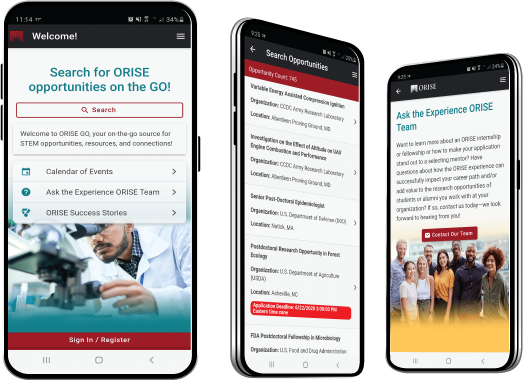USDA-FS Improving Fuel Model Prediction After Wildfire
To submit your application, scroll to the bottom of this opportunity and click APPLY.
A complete application consists of:
- An application
- Transcript(s) – For this opportunity, an unofficial transcript or copy of the student academic records printed by the applicant or by academic advisors from internal institution systems may be submitted. Click here for detailed information about acceptable transcripts.
- A current resume/CV, including academic history, employment history, relevant experiences, and publication list
- Two educational or professional recommendations. At least one recommendation must be submitted in order for the mentor to view your application.
All documents must be in English or include an official English translation.
Connect with ORISE...on the GO! Download the new ORISE GO mobile app in the Apple App Store or Google Play Store to help you stay engaged, connected, and informed during your ORISE experience and beyond!
*Applications will be reviewed on a rolling-basis.
USDA Forest Service Office/Lab and Location: A fellowship opportunity is available with the US Department of Agriculture (USDA) Forest Service (FS) within the Rocky Mountain Research Station (RMRS) located in Missoula, Montana.
At the heart of the USDA Forest Service's mission is their purpose. Everything they do is intended to help sustain forests and grasslands for present and future generations. Why? Because their stewardship work supports nature in sustaining life. This is the purpose that drives the agency’s mission and motivates their work across the agency. It’s been there from the agency’s very beginning, and it still drives them. To advance the mission and serve their purpose, the USDA Forest Service balances the short and long-term needs of people and nature by: working in collaboration with communities and our partners; providing access to resources and experiences that promote economic, ecological, and social vitality; connecting people to the land and one another; and delivering world-class science, technology and land management.
Research Project: Making informed decisions in wildfire management is critical to protect human life and infrastructure. Over the past seven years, the Potential Control Location Suitability model has been adopted by incident command teams as an important situational awareness tool that can be used to weigh strategic tradeoffs and help inform where the best opportunities and greatest challenges for containing a wildfire are likely to be. In its current state the model is produced annually at a coverage of the western United States and is available prior to the onset of fire season. As such, the model does not incorporate the variability in control opportunities and challenges that evolve over the course of a fire event. The model is helpful to determine where control opportunities exist but not when and under what conditions they are likely to be useful. For this reason, we have assembled a research team to explore new methods and new data that will improve foundational fuel structure and flammability information that will allow the model to adapt to changing conditions and dramatically improve its utility to support tactical decision making on large wildfires.
Opportunity Details: ALS (aerial laser scanning) is known for its use in capturing widespread forest inventory information with high accuracy. This information is useful to land managers in many different contexts, including fuels management for wildfire risk-assessment. However, ALS can be very expensive, especially when needing landscape scale areas flown. Some agencies, like Washington Department of Natural Resources (WDNR), are building an ALS inventory on a set multi-year interval. This provides an opportunity to monitor changing fuels. However, wildfire burn scars are known to alter fuel structure and flammability; and burn scars potentially useful for strategic fire containment occur at a rate much faster than ALS scans.
This research will address the gap between ALS inventory scans and burn scar formation through field plot-based Terrestrial LiDAR Scans (TLS) taken within recent burn scars (1-4 years post-fire). Sampling across a range of pre-fire forest vegetation-types and post-fire burn severity measurements will enable production of high-resolution surface and canopy fire behavior fuel models that can be used to update post-fire fuel estimates across the study area.
ORISE Fellow Activities:
- Develop a field-based sampling protocol to sample surface and canopy fuel conditions within recent burn scars on the Okanogan-Wenatchee National Forest.
- Be a part of TLS-based data collection over the summer of 2025.
- Collaborate with USDA-FS and University partners to identify, collect, develop, or improve upon surface and canopy fire behavior fuel model datasets that can be used in a dynamic PCL Model.
- Explore modeling approaches, data structures, and techniques to assist with modeling efforts
- Develop methods to assess model accuracy, scalability, and utility for use in wildland fire decision making.
- Model sensitivity analysis and testing on independent data
- Development of automated scripts to streamline production and scalability
- Collect feedback for fire managers and decision makers on model performance and ease of use.
Learning Objectives: The candidate will gain valuable experience developing field sampling protocols, determining representative sampling sites, and learning about leading a field crew to execute the sampling plan. As part of this research the candidate will learn protocols for field-based TLS systems, data collection and processing, archiving, and modeled integration with aerial LiDAR systems. Additionally, the candidate will learn techniques to integrate multiple data sources through machine learning and regression modeling to predict post-fire landscape attributes from field-based and remotely sensed vegetation and fuel structure metrics. The candidate will have an opportunity to be a part of publication of this research and to engage directly with other team members to integrate field-based model outputs into the larger fire containment modeling framework.
The candidate will collaborate with researchers to develop and test modelling methods, data quality, model sensitivity, accuracy, and stability, and to develop workflows and scripting to improve model scalability.
Mentor: The mentor for this opportunity is Kit O'Connor (christopher.d.oconnor@usda.gov). If you have questions about the nature of the research, please contact the mentor.
Anticipated Appointment Start Date: May 2025. Start date is flexible and will depend on a variety of factors.
Appointment Length: The appointment will initially be for 8 months but may be extended upon recommendation of USDA Forest Service and is contingent on the availability of funds.
Level of Participation: The appointment is part time.
Participant Stipend: The participant will receive a monthly stipend commensurate with educational level and experience.
Citizenship Requirements: This opportunity is available to U.S. citizens only.
ORISE Information: This program, administered by ORAU through its contract with the U.S. Department of Energy (DOE) to manage the Oak Ridge Institute for Science and Education (ORISE), was established through an interagency agreement between DOE and USDA Forest Service. Participants do not become employees of USDA, USDA Forest Service, DOE or the program administrator, and there are no employment-related benefits. Proof of health insurance is required for participation in this program. Health insurance can be obtained through ORISE.
Questions: Please visit our Program Website. After reading, if you have additional questions about the application process please email ORISE.USFS.RMRS@orau.org and include the reference code for this opportunity.
The qualified candidate should be currently pursuing or have received a master's degree in the one of the relevant fields. Degree must have been received within the past one year, or anticipated to be received by 9/30/2025.
- Citizenship: U.S. Citizen Only
- Degree: Master's Degree received within the last 12 months or anticipated to be received by 9/30/2025 12:00:00 AM.
-
Discipline(s):
- Environmental and Marine Sciences (4 )

 ORISE GO
ORISE GO

The ORISE GO mobile app helps you stay engaged, connected and informed during your ORISE experience – from application, to offer, through your appointment and even as an ORISE alum!





